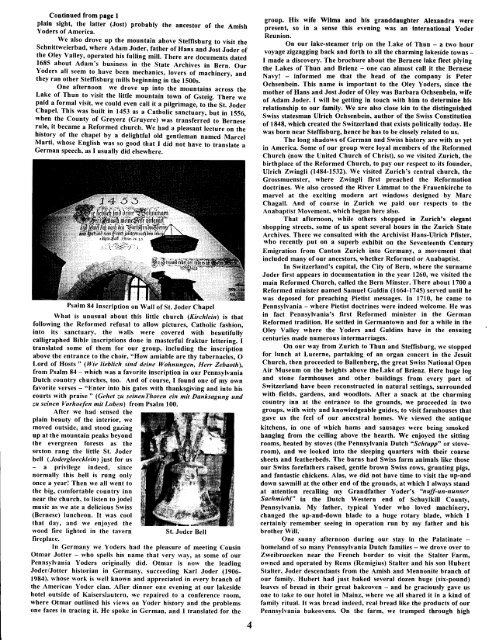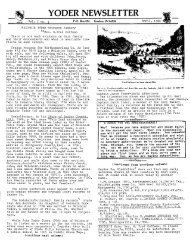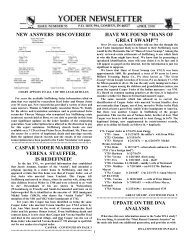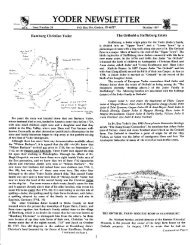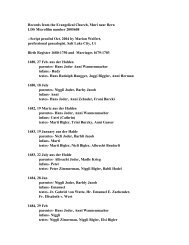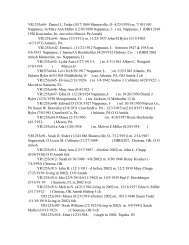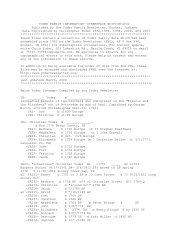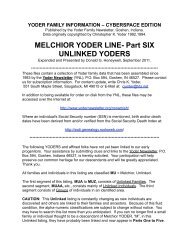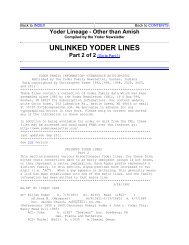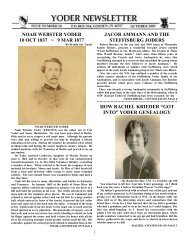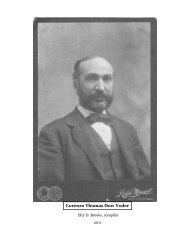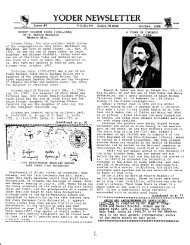w YODER NEWSLETTER - Yoder Family Information
w YODER NEWSLETTER - Yoder Family Information
w YODER NEWSLETTER - Yoder Family Information
Create successful ePaper yourself
Turn your PDF publications into a flip-book with our unique Google optimized e-Paper software.
Continued from page I<br />
plain sight, the latter (Jost) probably the ancestor of the Amish<br />
<strong>Yoder</strong>s of America.<br />
We<br />
-<br />
also drove up the mountain above Steffisburg to visit the<br />
Schnittweierbad, where Adam Joder, father ofHans and Jost Joder of<br />
the oley valley, operated his fuiling mil. There are documents dated<br />
1685 about Adam's business in the State Archives in Bern. Our<br />
<strong>Yoder</strong>s all seem to have been mechanics, lovers of machinerv. and<br />
they ran other Steffisburg mills beginning in the 1500s.<br />
One afternoon we drove up into the mountains across the<br />
Lake of Thun to visit the little mountain town of Gsteig, There we<br />
paid a formal visit, we could even call it a pilgrimage, to the St. Joder<br />
Chapel. This was built in 1453 as a Catholic ,"n"iuu.y, but in 1556,<br />
when the County of Greyerz (Gruyere) was transferred to Bernese<br />
rule, it became a Reformed church. We had a pleasant lecture on the<br />
history of the chapel by a delightful old genileman named Marcel<br />
Marti, whose English was so good that I did not have to translate a<br />
German speech, as I usually did elsewhere.<br />
Psalm 84 Inscription on Wall of St. Joder Chapel<br />
What is unusual about this little church (Kirchlein) is that<br />
following the Reformed refusal to allow pictures, Catholic fashion,<br />
into its sanctuary, the walls were covered with beautifully<br />
calligraphed Bible inscriptions done in masterful fraktur lettering. I<br />
translated some of them for our group, including the inscription<br />
above the entrance to the choir, "How amiable are thy tabernacles, O<br />
Lord of Hosts " (llie lieblich sind deine Hr'ohnungen, Herr Zebaoth),<br />
from Psalm 84 - which was a favorite inscription in our Pennsylvania<br />
Dutch country churches, too. And of course, I found one of my own<br />
favorite verses - "Enter into his gates with thanksgiving and into his<br />
courts with praise " (Gehet zu seinenThoren ein mit Danksagung und<br />
zu seinen Vorhoefen mit Loben) from Psalm 100.<br />
After we had sensed the<br />
plain beauty of the inlerior, we<br />
moved outside. and stood gazing<br />
up at the mountain peaks beyond<br />
the evergreen forests as the<br />
sexton rang the little St. Joder<br />
bell (Jodergloeckleinl just for us<br />
- a privilege indeed, since<br />
normally' this bell is rung only<br />
once a year! Then we all went to<br />
the big, comfortable country inn<br />
near the church, to listen to jodel<br />
music as we ate a delicious Swiss<br />
(Bernese) luncheon. It was cool<br />
that day, and we enjoved the<br />
wood fire lighted in the tavern<br />
St. Joder Bell<br />
fireplace.<br />
In Gcrmany we <strong>Yoder</strong>s had the pleasure of meeting Cousin<br />
Otmar Jotter - who spells his name that very way, as some of our<br />
Pennsvlvania <strong>Yoder</strong>s originally did. Otmar is now the leading<br />
Joder/Jotter historian in Germany, succeeding Karl Joder (1906-<br />
1984), whose work is well knorvn and appreciated in every branch of<br />
the American <strong>Yoder</strong> clan. After dinner one evening at our lakeside<br />
hotel outside of Kaiserslautern, we repaired to a conference room,<br />
where Otmar outlined his views on <strong>Yoder</strong> history and the problems<br />
one faces in tracing it. He spoke in German, and I translated for the<br />
4<br />
group. His wife Wilma and his granddaughter Alexandra were<br />
present, so in a sense this evening was an international <strong>Yoder</strong><br />
Reunion,<br />
On our lake-steamer trip on the Lake of Thun - a two hour<br />
yoyage zigzagging back and forth to all the charming lakeside towns -<br />
I made a discovery. The brochure about the Bernese lake fleet plying<br />
the Lakes of Thun and Brienz - one can almost call it the Bernese<br />
Navy! - informed me that the head of the company is Peter<br />
Ochsenbein. This name is important to the Oley <strong>Yoder</strong>s, since the<br />
mother of Hans and Jost Joder of Oley was Barbara Ochsenbein, wife<br />
of Adam Joder. I will be getting in touch with him to determine his<br />
relationship to our family. We are also close kin to the distinguished<br />
Swiss statesmatr Ulrich Ochsenbein, author of the Swiss Constitution<br />
of 1848, which created the Switzerland that exists politically today, He<br />
was born near Steffisburg, hence he has to be closely related to us.<br />
The long shadows of German and Swiss history are with us yet<br />
in America. Some of our group were loyal members of the Reformed<br />
Church (now the United Church of Christ), so we visited Zurich, the<br />
birthplace ofthe Reformed Church, to pay our respect to its fouDder,<br />
Ulrich Zwingli (1484-1532), We visited Zurich's central church, the<br />
Grossmuenster, where Zwingli first preached the Reformation<br />
doctrines. We also crossed the River Limmat to the Frauenkirche to<br />
marvel at the exciting modern art windows designed by Marc<br />
Chagall. And of course in Zurich we paid our respects to the<br />
Anabaptist Movement, which began here also.<br />
That aftcrnoon, while others shopped in Zurich's elegant<br />
shopping streets, some of us spent several hours in the Zurich State<br />
Archives. There we consulted with the Archivist Hans-Ulrich Pfister,<br />
who recently put on a superb exhibit on the Seventeenth Century<br />
Emigration from Canton Zurich into Germany, a movement that<br />
included many of our ancestors, whether Reformed or Anabaptist.<br />
In Switzerland's capital, the City of Bern, where the surname<br />
Joder first appears in documentation in the year 1260, we visited the<br />
main Reformed Church, called the Bern Minster. There about 1700 a<br />
Reformed minister named Samuel Guldin (1664-1745) served until he<br />
was deposed for preaching Pietist messages. In 1710, he came to<br />
Pennsylvania - where Pietist doctrines were indeed welcome. He was<br />
in fact Pennsylvania's first Reformed minister in the German<br />
Reformed tradition. He settled in Germantown and for a while in the<br />
Oley Valley where the <strong>Yoder</strong>s and Guldins have in the ensuing<br />
centuries made numerous intermarriages.<br />
On our way from Zurich to Thun and Steffisburg, we stopped<br />
for lunch at Lucerne, partaking of an organ concert in the Jesuit<br />
Church, then proceeded to Ballenberg, the great Swiss National Open<br />
Air Museum on the heights above theLake of Brienz. Here huge log<br />
and stone farmhouses and other buildings from every part of<br />
Switzerland have been reconstructed in natural settings, surrounded<br />
with fields, gardens, and woodlots. After a snack at tbe charming<br />
country inn at the entrance to the grounds, we proceeded in two<br />
groups, with witty and knowledgeable guides, to visit farmhouses that<br />
gave us the feel of our ancestral homes. We viewed the antique<br />
kitchens, in one of which hams and sausages were being smoked<br />
hanging from the ceiling above the hearth, We enjoyed the sitting<br />
rooms, heated by stoves (the Pennsylvania Dutch "Schtupp" or stov€room),<br />
and we looked into the sleeping quarters with their coarse<br />
sheets and feathertreds. The barns had Swiss farm animals like those<br />
our Swiss forefathers raised, gentle brown Swiss cows, grunting pigs,<br />
and fantastic chickens. Alas, we did not have time to visit the up-and<br />
down sawmill at the other end of the grounds, at which I always stand<br />
at attention recalling my Grandfather <strong>Yoder</strong>'s "nuff-un-nunner<br />
Saehmiehl" in the Dutch Western end of Schuylkill County,<br />
Pennsylvania. My father, typical <strong>Yoder</strong> who loved machinery,<br />
changed the up-and-down blade to a huge rotary blade, which I<br />
certainly remember seeing in operation run by my father and his<br />
brother Will.<br />
One sunny afternoon during our stay in the Palatinate -<br />
homeland of so many Pennsylvania Dutch families - we drove over to<br />
Zweibruecken near the French border to visit the Stalter Farm,<br />
owned and operated by Rems (Remigius) Stalter and his son Hubert<br />
Stalter. Joder descendants from the Amish and Mennonite branch of<br />
our family. Hubert had just baked several dozen huge (six-pound)<br />
loaves of bread in their great bakeoven - and he graciously gave us<br />
one to take to our hotel in Mainz, where we all shared it in a kind of<br />
family ritual. It was bread indeed, real bread like the products of our<br />
Pennsylvania bakeovens. On the farm, we tramped through high


